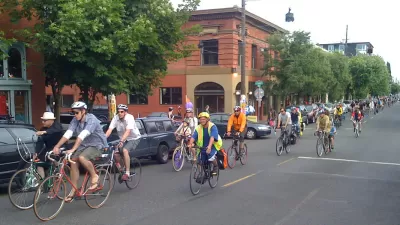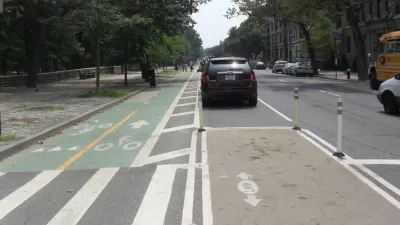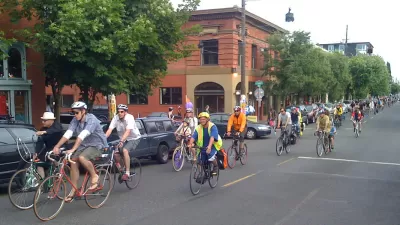In retrospect, it may seem like Portland’s biking boom was inevitable. But not too long ago the city was eclipsed by other Pac NW cities for share of bicycle commuters. What happened between 2002-2008 to kick-start the city’s bike craze?

Between 1990 and 2011, many of the largest cities in North America witnessed an increase in their percentage of bicycle commuters. But none has been more dramatic than the spike seen in Portland, where the mode share increased from 1.1 percent to 6.8 percent over that period. Seattle, for instance, increased from 1.5 percent to 3.7 percent.
“What happened? Why did Portland cycling rates increase so much more than other leading bike cities?” ask Michael Andersen and Jonathan Maus, editors for BikePortland. They cite 2002-2008 as the key years when bicycle commuting took off in the city, and propose five possible factors that contributed to its astonishing rise.
One theory involves the influence of instilling fun in pedaling via events led by groups such as Shift. Others include: the work of City staff “advocrats” pushing forward bicycle-friendly design enhancements; intuitive marketing and outreach approaches; and engaged citizen advocates.
FULL STORY: What caused Portland's biking boom?

Maui's Vacation Rental Debate Turns Ugly
Verbal attacks, misinformation campaigns and fistfights plague a high-stakes debate to convert thousands of vacation rentals into long-term housing.

Planetizen Federal Action Tracker
A weekly monitor of how Trump’s orders and actions are impacting planners and planning in America.

San Francisco Suspends Traffic Calming Amidst Record Deaths
Citing “a challenging fiscal landscape,” the city will cease the program on the heels of 42 traffic deaths, including 24 pedestrians.

Half of Post-Fire Altadena Home Sales Were to Corporations
Large investors are quietly buying up dozens of properties in Altadena, California, where a devastating wildfire destroyed more than 6,000 homes in January.

Opinion: What San Francisco’s Proposed ‘Family Zoning’ Could Really Mean
Mayor Lurie is using ‘family zoning’ to encourage denser development and upzoning — but could the concept actually foster community and more human-scale public spaces?

Jacksonville Launches First Autonomous Transit Shuttle in US
A fleet of 14 fully autonomous vehicles will serve a 3.5-mile downtown Jacksonville route with 12 stops.
Urban Design for Planners 1: Software Tools
This six-course series explores essential urban design concepts using open source software and equips planners with the tools they need to participate fully in the urban design process.
Planning for Universal Design
Learn the tools for implementing Universal Design in planning regulations.
Gallatin County Department of Planning & Community Development
Heyer Gruel & Associates PA
JM Goldson LLC
City of Camden Redevelopment Agency
City of Astoria
Transportation Research & Education Center (TREC) at Portland State University
Jefferson Parish Government
Camden Redevelopment Agency
City of Claremont




























